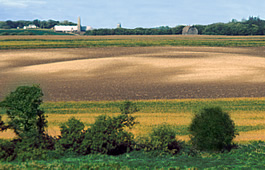This page has been archived and is being provided for reference purposes only. The page is no longer being updated, and therefore, links on the page may be invalid.
| Read the magazine story to find out more. |
|
|
The Hills Are Sagging
By Don ComisDecember 8, 2005
The pallid color of the North American prairies' rolling landscape is a tell-tale sign of soil erosion. The hilltop knobs have lighter-colored soil and less lush, green wheat than do the hill bottoms. This was long thought to be the result of dry soil only.
Researchers at the Agricultural Research Service (ARS) North Central Soil Conservation Laboratory in Morris, Minn., studied one such wheat field and found that gravity and erosion from annual plowing also have a great deal to do with the pallid soil. After more than 40 years of annual plowing, tillage erosion moved more than 27 tons of soil an acre a year in some spots, with water erosion moving another 9 tons an acre. The light spots are where topsoil moved down the hill, exposing shallow subsoil whitened by calcium.
Wheat yields on the knob were at most half of those on the rest of the field, with the highest yields on hill bottoms.
ARS soil scientists Sharon Papiernik and Mike Linstrom, now retired but working as a collaborator, are doing this research with scientists at South Dakota State University and the University of Manitoba in Canada.
Tillage and gravity erode soil the most under conditions such as these knobs, where there is a change from a relatively flat hilltop to a steep slope. Topsoil accumulates near the bottom of the hill where the steep slope becomes relatively flat land.
This also points to the possibility that using earth-moving equipment to move topsoil back up the hill-as several are farmers are doing-could increase yields enough to justify the expense.
For a follow-up study, Papiernik and colleagues are investigating the economic and environmental effects.
Read more about the research in the December 2005 issue of Agricultural Research magazine.
ARS is the U.S. Department of Agriculture's chief scientific research agency.

